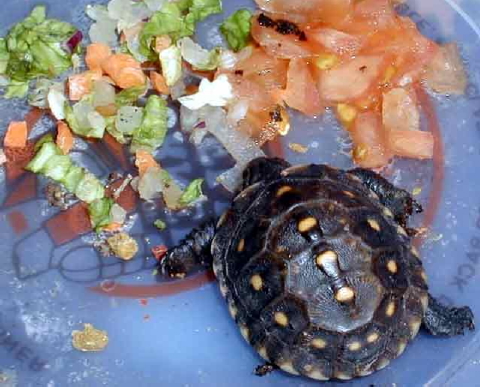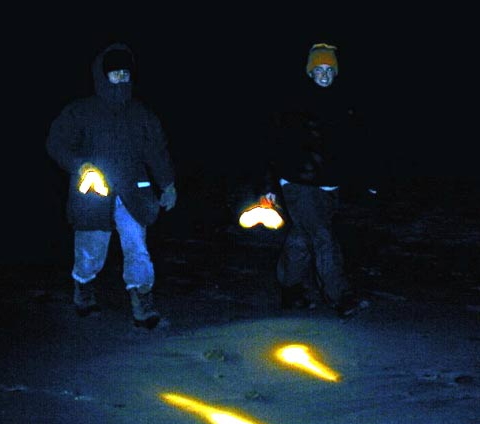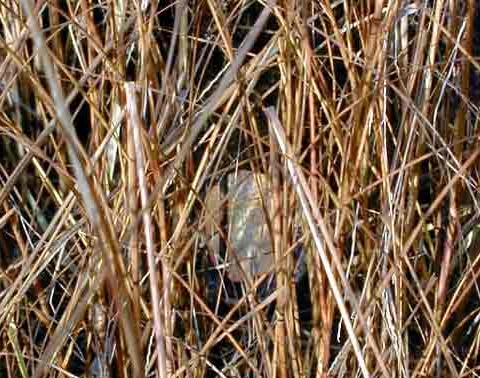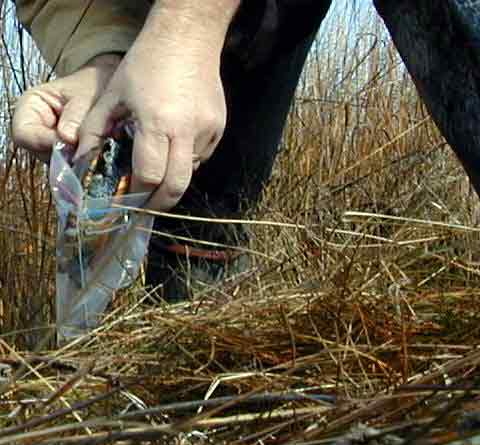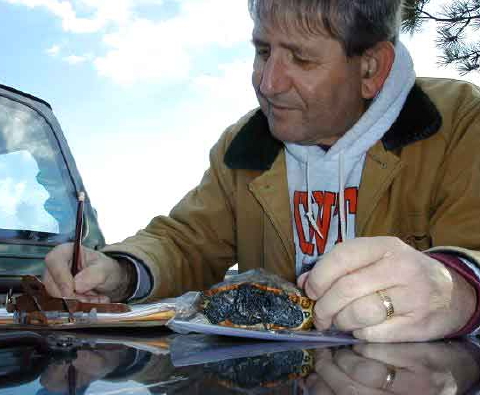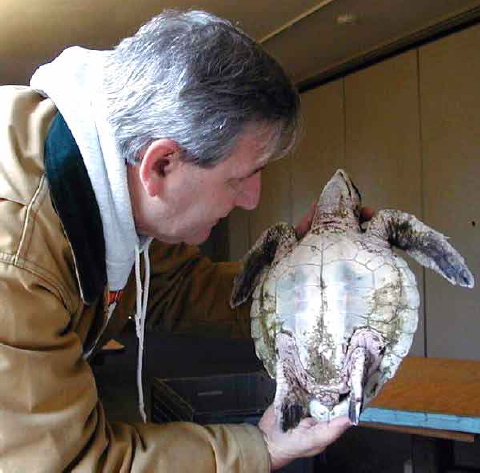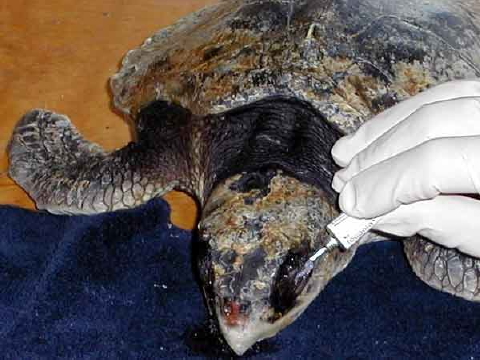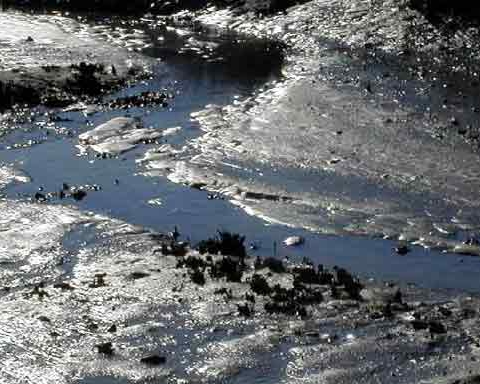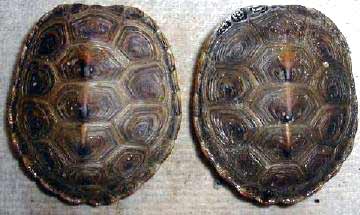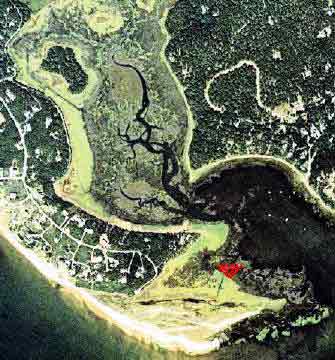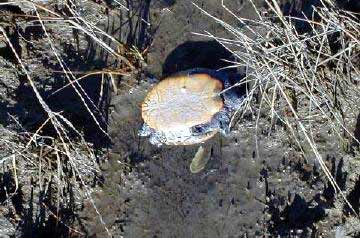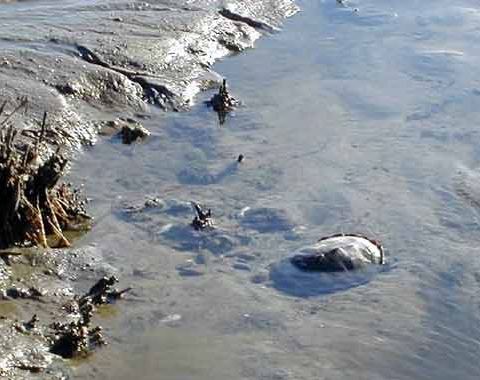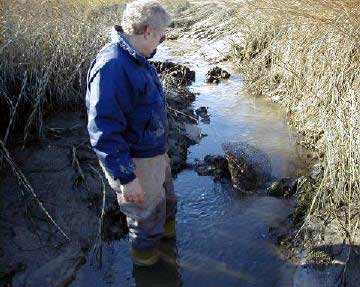Eastern Box Turtle Hatchling’s Thanksgiving Feast
Archive for November, 2000
Happy Thanksgiving Day 2000 — Flower’s Feast
Wednesday, November 22nd, 2000Night Sea Turtle Patrol — 21 November 2000
Monday, November 20th, 2000Fox Island Marsh Surrenders Another Dead Terrapin — 20 November 2000
Monday, November 20th, 2000Fox Island Wildlife Management Area
Acres of tall marsh grass still mask the extent of this year’s terrapin die-off in the Fox Island Wildlife Management Area. The improbability of finding dead turtles trapped in these thickets will remain astronomically high until winter storms and ice floes scythe the field.
Young Dead Female Terrapin Found in High Grass
Yet we were able this morning to spot the plastron of a young female, barely visible through dying grass stalks at the east edge of Field Point.
Don Lewis Bags Recovered Terrapin Carcass
Encouraged by this find, we waded deeper into the marsh only to back off when Rags plopped into a quick-mud creek channel disguised by the dense vegetation. Better to retreat with honor and limbs intact to return another day.
Don Lewis Documents Impact of Terrapin Deaths
The remains proved to be a prepubescent 8-year-old female — a significant loss to the Wellfleet population. Maybe a year short of sexual maturity, she had escaped the many and obvious threats to survival since her birth in the early 90s. She had avoided nest predation, which reaches more than 90 percent. She evaded predators stalking hatchlings as they emerge and race for the tidal marsh. She survived infancy when her tiny size represented a tasty morsel to a host of marsh critters. She lived through eight harsh winters, burrowed under black ooze for seven months of the year. At her current size and age, she had outgrown nearly every predator and threat. And now she was about to enter the most important and productive phase for the health of the terrapin population. Because turtles are such long-lived and slow-growing animals, mature females are the critical lynchpin in terrapin survival. Researchers have estimated that it takes a female turtle nearly 10 years of full sexual production to lay enough eggs to simply replace herself. We can’t afford to lose many turtles such as this one.
Cautionary Tale: Fifth Kemp’s Ridley of the Season — 19 November 2000
Sunday, November 19th, 2000Live “Dead” Kemp’s Ridley Rescued from Eastham Beach
This morning a beach walker discovered a Kemp’s ridley sea turtle north of Kingsbury Beach in Eastham. Showing no obvious signs of life, the turtle was left exposed on a washed-ashore tire. Hours later, the discoverer phoned the Wellfleet Bay Sanctuary to report finding “a dead turtle.â€
Don Lewis Examines Cold-Stunned Kemp’s Ridley
Cold-stunned and now further chilled and dehydrated from exposure, this plucky juvenile still clung to life. At only 9.5 inches long and less than 5 pounds, she had lost considerable body heat, registering an internal temperature of only 52°F, and she had sustained some nasty cuts and abrasions as she was driven helplessly ashore.
Kemp’s Ridley Stabilized for Emergency Trip to Boston
Her partly opened eyes, which displayed no movement, were cleaned and dowsed in a protective ointment. Her nose had been bruised and bloodied in beaching, as had the side of her head, underneath her neck, and the nail area of her left rear flipper. But to enhance her chance of survival, after a rocky start on the beach, we immediately rushed her to the New England Aquarium, where her injuries and hypothermic condition could be more aggressively treated.
Turtle “Hand-Off” at Sagamore Bridge
The handoff took place at the Sagamore Bridge rotary, mid-way between Boston’s New England Aquarium and Wellfleet Bay at the end of the universe. The fifth Kemp’s ridley of the season sped off with NEAQ’s Marine Animal Rescue, along with our hopes and prayers for her recovery. The important lesson for everyone associated with strandings is treat every beached critter as alive. When dealing with the rarest and most endangered sea turtle in the world, always err on the side of life.
Sweeping the Land of Ooze — 16 November 2000
Thursday, November 16th, 2000Oozy Low Tide Drained Marsh Channel on Indian Neck
This morning’s low tide offered a chance to sweep the Land of Ooze for potentially lethal debris. As we slogged through the Indian Neck creeks, we found two dead five-year-old females within a few feet of each other south of Fox Island.
Two Nearly Identical Dead Five-Year-Old Terrapins
One of these “twins†measured 8.7 cm, the second 8.65 cm carapace length.
Location of Three More Dead Terrapins in Fox Island WMA
Three more dead terrapins were discovered in marsh channels north of Field Point, bringing the total to 20 dead terrapins in the Fox Island Wildlife Management Area the last two weeks.
Dead Male Last Seen Healthy and Vibrant on 30 September
One, a six-year-old male of 11.85 cm length, had last been observed on 30 September swimming through Blackfish Creek. He had apparently experienced such a good season that the researcher noted, “Chunky . . . hardly fits into shell with summer fat.â€
Dead 10-Year-Old Female Last Seen Heatlhy on June 3rd
Another, a 10-year-old female of 17.9 cm, was last seen on 3 June as she, too, swam through Blackfish Creek in seemingly perfect condition.
Bob Prescott Examines “Ghost” Netting Seining Tidal Flow
A little way further upstream, the main discharge channel on Field Point was blocked by netting, seining the tidal ebb and flow from the entire marsh area south of Wise Hill. While this blockage appeared the most serious threat, we also pulled scattered pieces of debris from throughout the Fox Island Wildlife Management Area marsh system. Still, the amount of material found this year falls far short of the last spring’s haul. Our hope is that we are gradually recovering this habitat from years of neglect and as we persevere, the terrapin death total in the marsh will decline as well.
